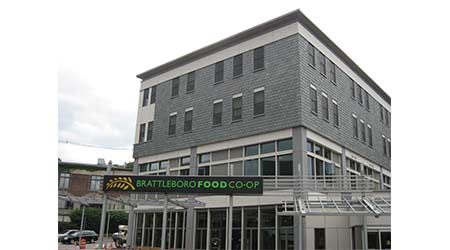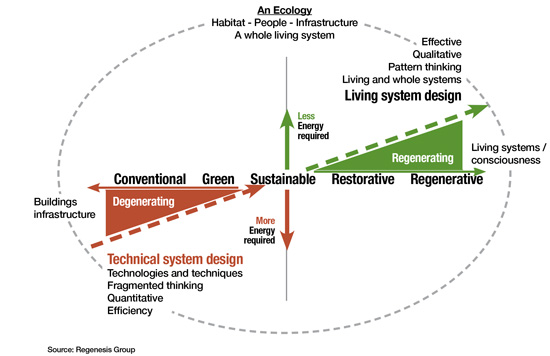 The LEED-Gold-certified Brattleboro Food Co-Op in Brattleboro, Vt., recognized the need for regenerative strategies to benefit the community at large.Courtesy Brattleboro Food Co-op.
The LEED-Gold-certified Brattleboro Food Co-Op in Brattleboro, Vt., recognized the need for regenerative strategies to benefit the community at large.Courtesy Brattleboro Food Co-op.Sustainability from Building To Community: On Regenerative Design
Fitting your building within the framework of the community is the next step in sustainability. Here's how.
Imagine if your building or project inspired better sustainability throughout its community. And as a result, the community looks to and supports your building as a catalyst for sustainable growth. Imagine if your building contributes to the health and well-being of not just its own inhabitants but the inhabitants of the surrounding neighborhood and community and perhaps the whole city and ecosystem in which it is situated. What if all buildings contributed to the sustainability, health, well-being, and prosperity of their communities, and that building and community continued to evolve together? This is a concept called regenerative development, which to some may seem far-fetched. But it’s happening every day.
The idea of sustainable buildings has become so commonplace that energy and resource efficiency have become expected attributes. But what do we mean by sustainable buildings? Taking a traditional point of view, we could say that sustainable buildings make it possible for future generations to enjoy the same quality of life that we currently have. In other words, sustainable buildings don’t use up resources and may even generate more (energy, fresh water) than they need. But are we accomplishing that with “sustainable,” LEED, and other green certified projects today? That question hardly needs answering because we can all see for ourselves; there is still much work to be done when we become present to the effects of climate change, pollution, and overconsumption of natural resources and the fact that we continue to de-generate our ecosystems rather than regenerating them.
If we think of green building on a trajectory from less bad to ongoing restoration and regeneration of the environment, where on that trajectory do you want to be? (See “Trajectory of Ecological Design" below.)
If regeneration is the goal, how do we get there? Certainly, you’ll want your building to be as resource-efficient as possible, hopefully striving for net zero energy, net zero water, and net zero waste. These imperatives are expressed in new rating systems and guides, like the Living Building Challenge. But do such lofty goals guarantee that your building will also restore and ultimately evolve with its community and environment? Maybe yes, probably no.
For a project or building to regenerate its community and ecosystem, it is helpful to think about it in the context of its place, as part of a nested system, which includes the project itself as the first level of system and the surrounding neighborhood or community as the second level of system. The third level of ecosystem could be the city, the watershed, or something else relevant to your community. Then think about the interactions between your building and the adjacent systems in which it is nested. If we design to incorporate the needs of the adjacent system, how would that affect our building? For instance, as will be discussed later, had the Brattleboro Food Co-op building just focused on its own LEED certification, the overall project might have missed an opportunity to stimulate the evolution of the surrounding farming community and the town.
It’s also important to be wary of what seem to be easy solutions. You may have a plaza or garden that is used by the community and that helps make the adjacent environment better for all. However, it is likely a stretch to say that the plaza, by itself, is sufficient to restore the systems in which it is nested.
Now that you may be thinking about your community differently, think about the ecological, geographic, cultural, economic, and climatic systems that affect each of the three levels of system. It can be a large amount of work to research these attributes, yet they help to distinguish the unique attributes and patterns of the place. Once pieced together in what could be called “the story of place,” one can begin to see how systems interact at all three levels and begin to see beyond obvious solutions, allowing designers to create a holistic vision to inform the design and development of a place.
Also think about: Which stakeholders represent the financial, human, social, natural, and produced capital of the place? How will you partner with them in the design and further development of your building and its community? How can they support and impact your building and the systems in which it is nested? Through the regenerative development process, we aim to nurture mutually beneficial relationships among all stakeholders such that the full potential of a building and its place is realized. The intent is that projects, through their stakeholders, co-evolve to create healthy and thriving communities and ecosystems.
TRAJECTORY OF ECOLOGICAL DESIGN
Trajectory of green building design: Green building is evolving from less bad to ongoing restoration and regeneration of the environment.
What is Regenerative Design? Regenerative Design describes processes that restore, renew, or revitalize their own sources of energy and materials, creating sustainable systems that integrate the needs of society with the integrity of nature.

Related Topics:














